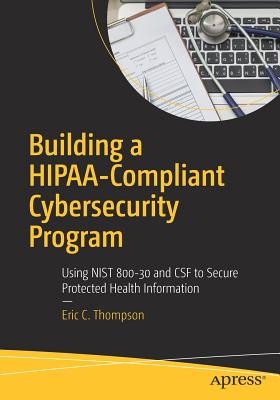
- We will send in 10–14 business days.
- Author: Eric C Thompson
- Publisher: Apress
- Year: 2017
- Pages: 297
- ISBN-10: 1484230590
- ISBN-13: 9781484230596
- Format: 17.8 x 25.4 x 1.7 cm, minkšti viršeliai
- Language: English
- SAVE -10% with code: EXTRA
Reviews
Description
Use this book to learn how to conduct a timely and thorough Risk Analysis and Assessment documenting all risks to the confidentiality, integrity, and availability of electronic Protected Health Information (ePHI), which is a key component of the HIPAA Security Rule. The requirement is a focus area for the Department of Health and Human Services (HHS) Office for Civil Rights (OCR) during breach investigations and compliance audits. This book lays out a plan for healthcare organizations of all types to successfully comply with these requirements and use the output to build upon the cybersecurity program.
With the proliferation of cybersecurity breaches, the number of healthcare providers, payers, and business associates investigated by the OCR has risen significantly. It is not unusual for additional penalties to be levied when victims of breaches cannot demonstrate that an enterprise-wide risk assessment exists, comprehensive enough to document all of the risks to ePHI.
Why is it that so many covered entities and business associates fail to comply with this fundamental safeguard? Building a HIPAA Compliant Cybersecurity Program cuts through the confusion and ambiguity of regulatory requirements and provides detailed guidance to help readers:
- Understand and document all known instances where patient data exist
- Know what regulators want and expect from the risk analysis process
- Assess and analyze the level of severity that each risk poses to ePHI
- Focus on the beneficial outcomes of the process: understanding real risks, and optimizing deployment of resources and alignment with business objectives
- Use NIST 800-30 to execute a risk analysis and assessment, which meets the expectations of regulators such as the Office for Civil Rights (OCR)
- Understand why this is not just a compliance exercise, but a way to take back control of protecting ePHI
- Leverage the risk analysis process to improve your cybersecurity program
- Know the value of integrating technical assessments to further define risk management activities
- Employ an iterative process that continuously assesses the environment to identify improvement opportunities
Who This Book Is For
Cybersecurity, privacy, and compliance professionals working for organizations responsible for creating, maintaining, storing, and protecting patient information
EXTRA 10 % discount with code: EXTRA
The promotion ends in 21d.21:30:34
The discount code is valid when purchasing from 10 €. Discounts do not stack.
- Author: Eric C Thompson
- Publisher: Apress
- Year: 2017
- Pages: 297
- ISBN-10: 1484230590
- ISBN-13: 9781484230596
- Format: 17.8 x 25.4 x 1.7 cm, minkšti viršeliai
- Language: English English
Use this book to learn how to conduct a timely and thorough Risk Analysis and Assessment documenting all risks to the confidentiality, integrity, and availability of electronic Protected Health Information (ePHI), which is a key component of the HIPAA Security Rule. The requirement is a focus area for the Department of Health and Human Services (HHS) Office for Civil Rights (OCR) during breach investigations and compliance audits. This book lays out a plan for healthcare organizations of all types to successfully comply with these requirements and use the output to build upon the cybersecurity program.
With the proliferation of cybersecurity breaches, the number of healthcare providers, payers, and business associates investigated by the OCR has risen significantly. It is not unusual for additional penalties to be levied when victims of breaches cannot demonstrate that an enterprise-wide risk assessment exists, comprehensive enough to document all of the risks to ePHI.
Why is it that so many covered entities and business associates fail to comply with this fundamental safeguard? Building a HIPAA Compliant Cybersecurity Program cuts through the confusion and ambiguity of regulatory requirements and provides detailed guidance to help readers:
- Understand and document all known instances where patient data exist
- Know what regulators want and expect from the risk analysis process
- Assess and analyze the level of severity that each risk poses to ePHI
- Focus on the beneficial outcomes of the process: understanding real risks, and optimizing deployment of resources and alignment with business objectives
- Use NIST 800-30 to execute a risk analysis and assessment, which meets the expectations of regulators such as the Office for Civil Rights (OCR)
- Understand why this is not just a compliance exercise, but a way to take back control of protecting ePHI
- Leverage the risk analysis process to improve your cybersecurity program
- Know the value of integrating technical assessments to further define risk management activities
- Employ an iterative process that continuously assesses the environment to identify improvement opportunities
Who This Book Is For
Cybersecurity, privacy, and compliance professionals working for organizations responsible for creating, maintaining, storing, and protecting patient information


Reviews